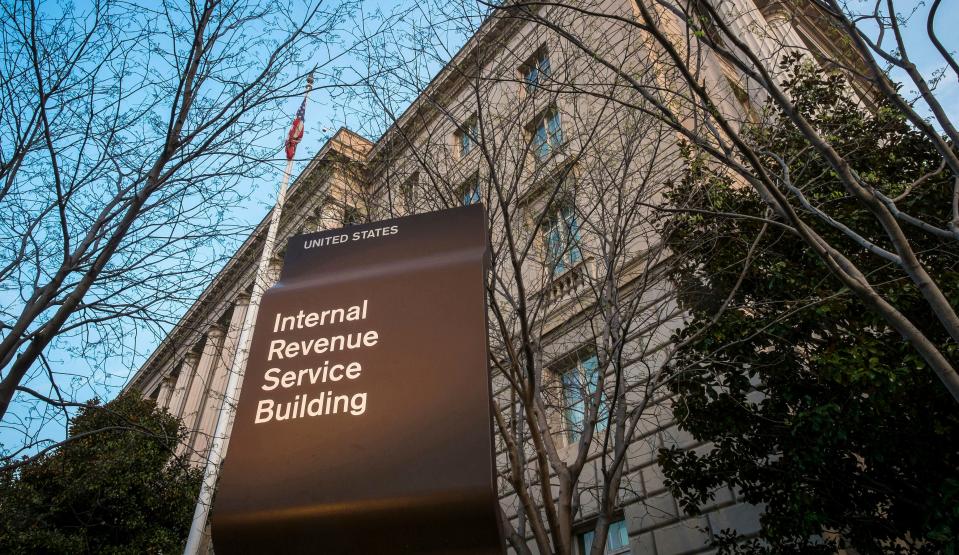Tax refunds are smaller this year: How to track, what it means for economy
Never-ending rounds of sticker shock — whether you're paying your winter heating bills or eating out on a date or facing mounting credit card bills — mean that more consumers need their tax refund cash now, as in right now.
Many very likely filed their tax returns as early as possible to get it.
Most taxpayers across the country have until April 18 to make the tax filing deadline. Many who wait and drag their feet often owe money, but some are owed tax refunds.
Springtime spending, no doubt, continues to be shored up by an influx of fresh refund cash. The average refund is $2,910 this year for federal income tax returns already filed and processed by March 31, according to the latest IRS data.
Some tax refund money will go to cover old bills and budget shortfalls. Some might go toward savings. But some money will be spent, too, even if only on a few extras, such as a dinner out or a weekend getaway.
Make no mistake, many people cannot bank on seeing anything close to the same flood of cash they benefited from a year ago now that pandemic-related tax breaks have expired.
More: 2023 tax season shows some hope as IRS answers calls, refunds roll out on time
Overall, taxpayers saw $183.13 billion in federal income tax refunds head their way through March 31. While that's a great deal of money, the total dollar amount is down $21.27 billion, or down 10.4%, from the same time period a year ago.
The average dollar amount of tax refunds was down 9.8% through March 31. A year ago through April 1, 2022, the average federal income tax refund was $3,226.
The latest IRS data showed that:
The IRS processed 0.4% more tax returns — including those that owed money — than it did a year ago through March 31.
The total number of refunds issued was down 0.7% through March 31.

What do smaller refunds mean for the economy?
"This tax refund season is injecting less into the economy," said Jonathan Smoke, chief economist for Cox Automotive.
The IRS, he said, launched the 2023 tax season on Jan. 23 and made good progress processing tax returns and issuing refunds at a faster pace than a year ago.
As a result, a big infusion of refund cash hit the economy early this year through February. By the end of March, he said, the economy is seeing less of a lift as people spend tax refund money.
Overall, this tax refund season will have less of a positive impact on retail sales, Smoke predicted, including big ticket items, such as used cars.
"We will likely see less consumer spending and weaker growth in the spring," Smoke said.
What's the impact on consumer credit?
Tax refunds, Smoke said, play a key role in consumer credit, too. Often, more consumers are better able to pay their bills on time and avoid defaulting on a car loan or other loan each spring because they have extra money through their tax refunds.
"We usually see the lowest delinquency rates of the year in the spring," Smoke said.
But he cautioned that this spring's data might not show much improvement in consumer credit performance.

Credit conditions are already tightening some because of the ongoing banking turmoil that started after panic spread, depositors withdrew large amounts of money, and a run on the bank led to Silicon Valley Bank failing on March 10.
Credit conditions could prove to be even tighter later this year, Smoke said, if more consumers aren't able to pay bills on time, driving up delinquencies.
Smoke said sales data show that the used car market has been losing momentum in March, especially compared with earlier this year, and smaller tax refunds are clearly one of the factors.
Used car and truck prices fell 13.6% year-over-year through February, according to the latest consumer price index data. New car and truck prices were up overall — 5.8% over 12 months through February.
Overall, the CPI rose 6% in February for all items. Inflation data for March will be released April 12.
More: Federal Reserve's smaller interest rate hike could indicate inflation easing a bit
More: Tax Day in Michigan: 15 questions you might have on due date, refunds, more
How can you track your tax refund?
The good news for many tax filers is that the IRS isn't experiencing the all-out disaster in its operations that it did a year ago. Things have been going more smoothly early in the season.
If you're owed a refund, you can track the process online.
See the "Where's My Refund" tool at IRS.gov. Information is updated once a day, overnight.
To use the tool, you must have your Social Security number or the Social Security number of the first person listed on the return, if married and filing a joint return; know your filing status and be able to type in the exact refund amount listed on the return.
The "Where's My Refund" tool has a bar chart that first lists whether the tax return was received, whether the refund was approved and later whether the refund was issued.
Once you get your answer, the IRS recommends that you close your browser for security reasons after you've tracked your refund status via IRS.gov.
If you electronically file your federal income tax return, it can take 24 hours to 48 hours for the IRS to accept the return into the system. The IRS is checking your personal information to make sure it matches what's on record.
For most returns, it can take up to 21 days to receive a refund via direct deposit. In some cases, it can take more time.
"If you filed on paper and are expecting a refund, it could take four weeks or more to process your return," according to an IRS update posted online Jan. 30.
A return that has mistakes, lacks all the necessary information or raises red flags regarding ID theft is going to take much longer to process.
How can you track your Michigan refund?
If you filed your state of Michigan income tax return, you can check online to find updates. See michigan.gov/taxes/iit/refund.
Typically, you need to wait two weeks from the date you received confirmation that your Michigan state income tax return was accepted via e-file before you can check for any information about your refund.
If you filed a paper return, Michigan's website notes that you need to wait six weeks before trying to check for any updates on your refund.
Why might my tax refund be delayed?
Several factors can cause the IRS to hold back your refund, such as:
You have unfiled or missing tax returns for prior tax years.
The refund check was held or returned due to a problem with the name or address.
You elected to apply the refund toward your estimated tax liability for next year.
The IRS is reviewing your tax return.
Your refund was applied to a debt you owe to the IRS or another federal or state agency.
Could I receive a smaller refund than expected?
Yes, it's possible that you could receive a smaller refund than expected. You might make a math error, for example, on your tax return that you file now and it could be corrected by the IRS and, possibly, lead to a smaller refund.
The Treasury's Bureau of Fiscal Service can also reduce your federal income tax refund and offset it to pay:
State income taxes.
Child support.
Overpayment of unemployment compensation, say in the case of fraud.
Federal agency non-tax debts, including past due federal student loans. Right now, the pandemic-related pause on many student debt payments for federal student loans has temporarily stopped federal tax refunds from being applied to defaulted student debt. Defaulted student loan borrowers get to keep their federal income tax refunds at this point. But this is a bit of temporary relief. It's not likely to be in place when you file your 2023 federal tax return in 2024.
The student loan payment pause, which applied to most federal student debt, has been extended until the U.S. Department of Education is permitted to implement President Joe Biden's debt relief program or the litigation is resolved. Payments will restart 60 days later.
The Education Department notes that if the debt relief program has not been implemented and the litigation has not been resolved by June 30, payments will resume 60 days after that.
Contact Susan Tompor: stompor@freepress.com. Follow her on Twitter @tompor. To subscribe, please go to freep.com/specialoffer.
This article originally appeared on Detroit Free Press: Tax refund status: How to track it online

